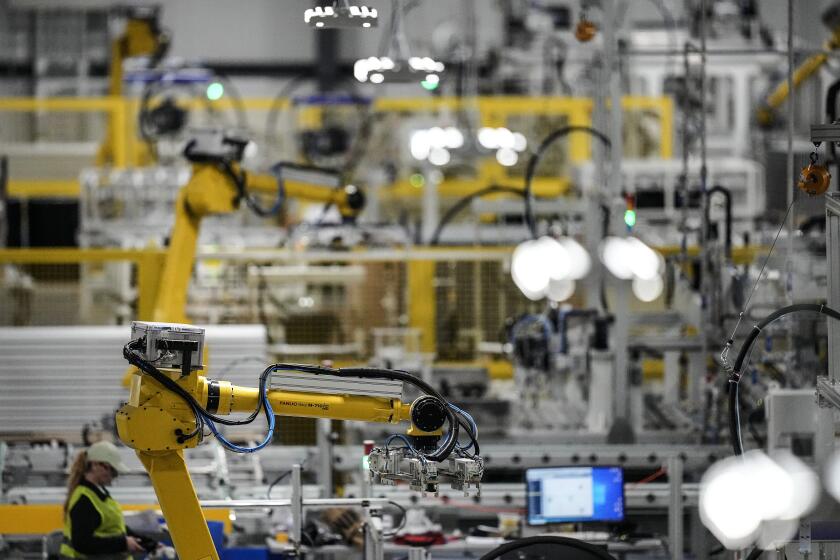Standing up to China
Tucked away in an industrial section of Sun Valley, QMP Inc. has built a steady flow of international customers for its water filtration systems.
But now the global economy is biting back.
QMP has lost about 40% of its customers in the last two years to Chinese firms that make filter systems for a third of its cost.
Chief Executive Freddy Vidal isn’t sure how much longer he can keep the family business in Southern California.
Vidal’s problem is shared by manufacturers across Southern California. Chinese manufacturing has become more sophisticated. At the same time, entrepreneurs there have gained a level of English proficiency that enables easier movement of design plans. Now, Southern California companies are finding that they can no longer compete simply by moving upscale and making small runs of specialized goods that couldn’t be reproduced on a mass scale.
“We’ve been losing customers because they want us to match the price of the Chinese products, which is impossible,” said Vidal, whose business employs 65. “If the situation doesn’t change soon, we’ll have to either close the company or play the same game and move our manufacturing operation to China.”
QMP collects about $5 million in revenue annually from faucets and other products that go to customers such as Home Depot Inc. in California and filtration systems to such foreign retailers as Water Shop in Australia and Air River Co. in Japan.
“China has had a huge impact on local manufacturing firms, causing them to reduce their operations and either produce in China or go out of business,” said Jack Kyser, chief economist with the Los Angeles County Economic Development Corp.
That cheap offshore production, combined with the region’s shrinking defense industry, has caused steady manufacturing job losses in the county over the last decade. Apparel, furniture, plastics and fabricated metal products industries have been hit the hardest.
Although Los Angeles County remains the nation’s largest manufacturing center, average annual manufacturing employment fell 27% to 462,000 jobs from 1996 to 2006.
To stay afloat, manufacturers in the region are focusing less on mass-market items and more on specially designed products, customer service and fast delivery of products.
“You can’t compete on price, so you have to compete on something the other guy can’t bring to the marketplace,” said David Braunstein, chief executive of California Manufacturing Technology Consulting of Torrance. “That’s forced manufacturers to be quicker and more innovative.”
Consider Stop Staring Designs Inc., which operates in the downtown Los Angeles fashion district. Founded in 1997 by Alicia Estrada, the business specializes in dresses inspired by 1940s and 1950s fashion and has a global customer base, including fashion boutiques in Canada, Germany and England where there is a strong demand for made-in-the-USA clothing.
The company has 14 full-time sales, design and showroom employees and hires Los Angeles subcontractors to perform more labor-intensive tasks such as cutting and sewing that can be performed much more cheaply in China.
“I’ve had people come to me at trade shows and say, ‘We’re an offshore production company and we can make this stuff for you at half the price of what you’re paying to have them made in L.A.’ It’s very tempting.”
But Estrada, an L.A. native who runs the business with her husband and other relatives, says keeping the operation here is not only desirable but also good business.
She can design and deliver an order for a certain style of dress in four to six weeks, about half the time it would take if the dress was made in China. And Estrada says having a presence in L.A. enables her to stay close to the newest fashion trends and closely monitor quality.
“If I want to walk over to a contractor and see what they’re doing, I can make sure they put on the correct trim and the correct button shades,” she said. “In China, you don’t know what the quality is.”
QMP’s strategy has been to push into Europe and Asia, where consumers prefer U.S.-made filters. The faucets are made from stainless steel and lead-free brass, making them more expensive but higher quality than those from China, Vidal says.
To broaden its appeal, QMP also has introduced products that are more consumer-friendly, such as a recently patented filter attached to the faucet that can be changed without going underneath the sink.
Additionally, the company has expanded its business in Chile and Venezuela and now operates an assembly plant in Vidal’s native Bolivia.
Palmdale-based U.S. Pole Co., which produces commercial lighting fixtures and poles for shopping malls and parks, can’t match China’s labor costs.
Instead, it keeps costs down by operating as a kind of soup-to-nuts manufacturing shop. Rather than rely on outside suppliers and subcontractors, U.S. Pole does its own die casting, sheet metal and paint work in house.
Chief Executive Joe Straus says that has several advantages: It enables the company to get products to market more quickly, ensure more consistent quality and modify designs to create more specialized products tailored to customers’ needs that mass producers in China can’t replicate.
Recently, for example, U.S. Pole introduced a line of outdoor lighting products with 92 design styles and six types of brackets.
“We modify our product and we make specialized types of products. China cannot do that. They only knock out cookies,” Straus said.
U.S. Pole’s rivals include giant U.S. firms such as Cooper Lighting that manufacture in China. And several Chinese manufacturers of lighting fixtures are attempting to muscle their way into the U.S. market. Nonetheless, U.S. Pole has grown steadily since its founding in 1984.
The company, which employs 315, outgrew its old location in Sun Valley and moved into a 110,000-square-foot plant in Palmdale in 2002. Sales have jumped 75% to about $50 million a year since 2000, Straus says.
Despite the mounting competition, Straus is confident that U.S. Pole will thrive.
“We’re much more responsive,” he said. “That gives us a big competitive edge.”
--







